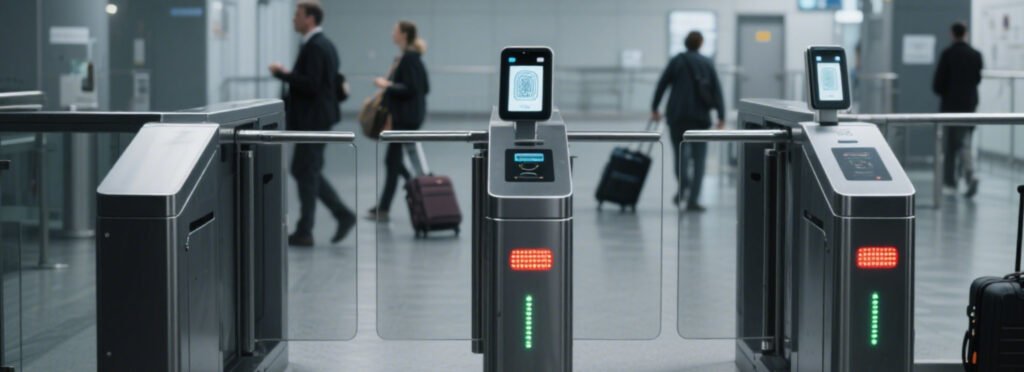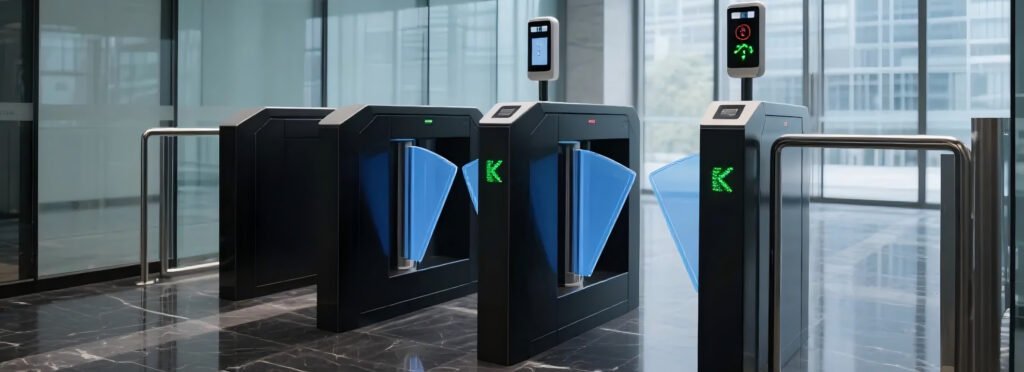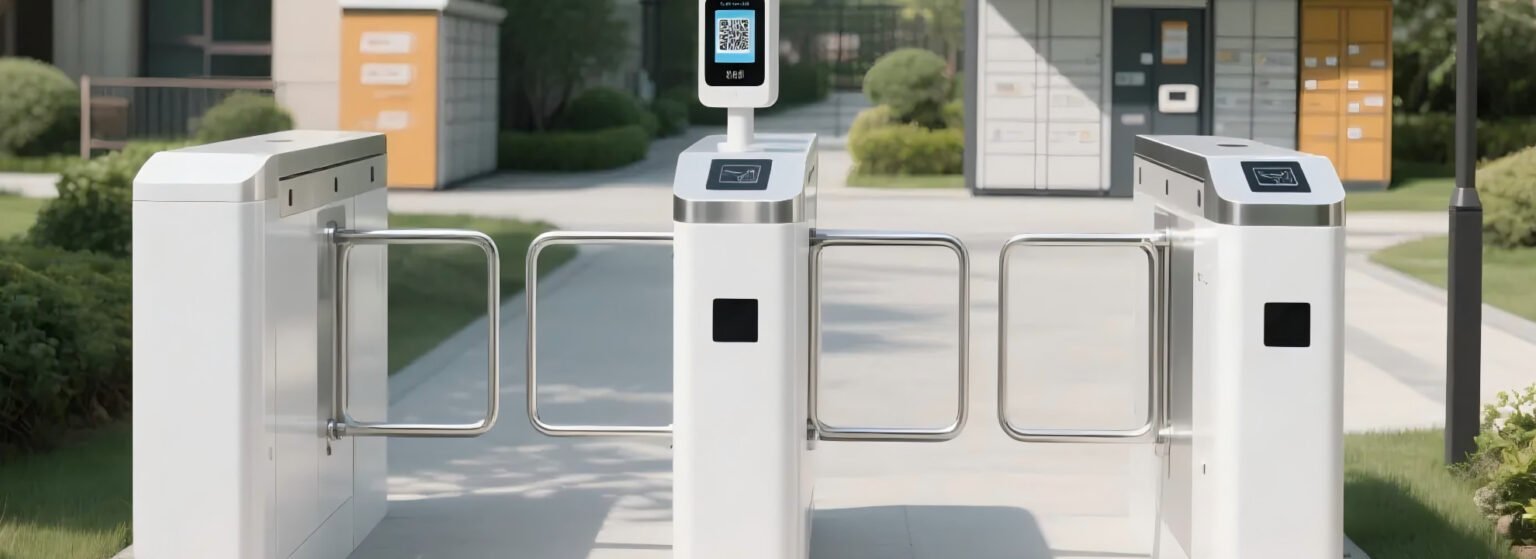Smart Swing Gate
Introduction – The Importance of Smart Access Control
Modern offices and public spaces need systems that balance safety and speed. Security threats are growing, and access control is essential for protecting people and assets. At the same time, employees, visitors, and customers expect quick, smooth passage without delays. Smart swing gates meet both needs by combining advanced technology with efficient design. They help control entry points while maintaining a welcoming atmosphere. For high-traffic environments, they reduce bottlenecks and improve the overall user experience.
Swing gates use arms or panels that rotate horizontally to allow passage. The design can accommodate wide lanes, which is ideal for wheelchairs or large items. They work well in spaces where aesthetics and accessibility are equally important. Unlike flap barriers, which open vertically, swing gates operate more smoothly and with less noise. They can integrate with RFID, QR codes, biometric scanners, and mobile credentials. Customizable materials and finishes allow them to fit seamlessly into different architectural styles.
Core Advantages of Swing Gates
Security
Swing gates block tailgating and stop unauthorized access effectively. They include anti-climb barriers, alarm systems, and safety sensors. These features protect users and equipment while keeping entry points secure.
Efficiency
They process high volumes of users without creating queues. Smooth operation helps keep people moving during peak times. Minimal waiting improves satisfaction and reduces stress for both visitors and staff.
Flexibility
They support multiple access methods such as cards, mobile apps, and face recognition. This flexibility adapts to the needs of offices, hospitals, and public facilities.
Integration
Swing gates connect with CCTV, visitor software, and building control systems. Integration enables central monitoring and better response to security incidents.
Practical Applications
Corporate Offices & Business Parks
Swing gates manage employee entry and secure sensitive areas. They record entry data to track attendance and improve workplace safety.
Government Buildings & Public Institutions
They allow quick verification of visitors while keeping restricted zones secure. This speeds up service without lowering security standards.
Healthcare Facilities & Hospitals
Gates ensure safe access for patients, visitors, and medical staff. Wide lanes allow easy passage for stretchers and medical equipment.
Commercial Centers & Shopping Malls
They handle constant high foot traffic smoothly. This ensures visitors enjoy a safe, seamless shopping experience.
How to Choose the Right Swing Gate
Selecting the right swing gate requires a careful balance between traffic flow, security needs, and design compatibility. Facilities with high foot traffic should choose gates with faster opening speeds and robust safety sensors. For buildings with mixed traffic, including wheelchair users or people carrying equipment, wider lane models are essential for smooth passage.
Security requirements also influence gate choice. High-security environments may require swing gates with integrated biometric authentication, while general offices can opt for simpler card or QR code systems. Integration with CCTV, access control software, and building management systems is another factor to consider, ensuring centralized monitoring and control.
The appearance of the swing gate should match the surrounding architecture. Stainless steel finishes, tempered glass panels, and LED indicators can create a professional and modern entrance. A well-chosen swing gate should not only perform reliably but also enhance the overall visitor experience.


Why Choose Swing Gates Over Flap Barriers
Swing gates offer a wider passage width, making them ideal for wheelchair users, strollers, or people carrying large items. This accessibility advantage is crucial for public buildings, hospitals, and shopping centers, where inclusivity is a priority. In contrast, flap barriers typically have narrower lanes, limiting movement for certain users and causing inconvenience during busy hours.
In terms of design versatility, swing gates blend more easily with modern architecture. Their glass or stainless steel panels can be customized to match interior aesthetics. LED indicators, slim profiles, and silent motors make them a discreet yet functional part of the entrance. Flap barriers, while efficient, often have a more industrial appearance, which may not suit premium or design-focused environments.
Swing gates also excel in multi-traffic handling. They allow the smooth passage of mixed groups, including people with trolleys, luggage, or equipment, without slowing down. Flap barriers work best in controlled, high-security areas but can be restrictive for diverse traffic types. In settings where comfort and flexibility are as important as speed, swing gates provide a better balance.
From a maintenance perspective, swing gates generally have fewer moving parts than flap barriers, resulting in reduced wear. The slower opening and closing motion puts less stress on the mechanism, extending lifespan and lowering maintenance costs. For facilities seeking long-term reliability with minimal downtime, swing gates offer a practical and cost-effective solution.

Compatible Identification Technologies for Swing Gates
One of the greatest strengths of swing gates is their compatibility with multiple identification systems. This flexibility allows facilities to adapt their access control to evolving security needs and user preferences.
Facial recognition
Which is a popular choice for high-traffic corporate offices and public institutions. It offers contactless, fast, and highly accurate verification, ideal for hygienic environments like hospitals or government buildings. The technology works seamlessly with swing gates, ensuring quick passage even during rush hours.
Palm vein recognition
This identification technology provides a secure and privacy-friendly alternative. By scanning the unique vein patterns inside the hand, it offers high resistance to forgery and works in diverse lighting conditions. This makes it suitable for secure labs, data centers, and restricted research areas.
Iris recognition
Iris recognition delivers unmatched accuracy for ultra-high security zones. It is non-intrusive, fast, and nearly impossible to replicate, making it a preferred choice in military facilities, border control, and critical infrastructure.
QR code scanning
QR code scanning is gaining popularity for visitor management systems. Guests can receive a digital code via email or mobile app, which they simply scan to gain entry. This method is ideal for events, exhibitions, and co-working spaces, where access credentials change frequently.
For more traditional setups, RFID or IC card readers remain widely used. They offer a balance between cost-effectiveness and efficiency, especially in offices, campuses, and residential complexes. Cards can also be paired with visitor badges for temporary access control.
Swing gates can integrate any of these technologies—either individually or in combination. Multi-factor authentication is also possible, for example combining facial recognition with card scanning, to meet the highest security requirements. This adaptability makes swing gates a future-proof investment for both small-scale and large-scale facilities.
Future Trends of Swing Gates
The future of swing gates is moving towards greater intelligence, speed, and sustainability. As urban spaces become smarter, swing gates will integrate more deeply with building management systems. This allows for centralized control of access, lighting, HVAC, and security, improving both efficiency and user experience.
Artificial intelligence will play a key role in enhancing security. AI-powered analytics will detect abnormal behaviors, prevent tailgating, and adjust access rules dynamically based on real-time risk assessment. Combined with machine learning, swing gates will continuously improve recognition accuracy and processing speed.The adoption of multi-modal biometric authentication will expand. Facilities will combine facial recognition, palm vein scanning, and QR code verification for stronger security without compromising convenience. This approach will also support touchless access, which remains a priority for health-conscious environments.
These trends will transform swing gates from simple access control devices into integrated security and management hubs, capable of adapting to future challenges while delivering a better, safer, and more efficient access experience.
